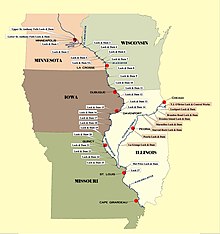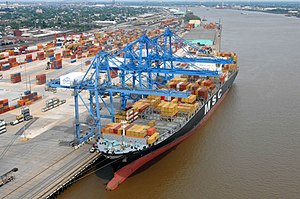Container on barge
This article has multiple issues. Please help improve it or discuss these issues on the talk page. (Learn how and when to remove these template messages)
|

Container on barge is a form of
Mississippi River & tributaries


There is limited use of this mode of transport because a lack of infrastructure on the upriver side in the United States. With the development of the Louisiana International Gulf Transfer Terminal at the mouth of the Mississippi River, container on barge traffic could become mainstream.
Missouri River
The Missouri River has no lock and dams on it and from Omaha, Nebraska to St. Louis and there is only one lock and dam above St. Louis to lock through, the Chain of Rocks Lock, to get to the lower Mississippi.
Ohio River
The Ohio River has 21 locks all the way up to Pittsburgh and locking through takes about 30–45 minutes with a full 3x5, 15 unit barge.
Upper Mississippi
The Upper Mississippi has 25+ locks and dams from St. Louis to Minneapolis that are 600-foot locks and only allow 6 to 8 barge units per tow without having to double lock through gates (double locking takes 2 hours+).
Lower Mississippi
The Lower Mississippi from St. Louis to the Port of New Orleans has no locks or dams and allows barges up to 7x6 or 42 barge units per tow. Oceangoing ships with drafts of 45 feet and height clearances over 150 feet can navigate the waters up to Baton Rouge.
United States plans
Plans have been developed to create container terminals at the mouth of the Mississippi and St. Louis by Q4 2024.

References
- ^ "St. Louis Container on Barge Project Moves Forward". 17 December 2021.
- ^ "Gov. Edwards: Louisiana lines up partners for $1.8 billion container terminal project in St. Bernard". 13 December 2022.
- ^ "St. Louis Container on Barge Project Moves Forward". 17 December 2021.
